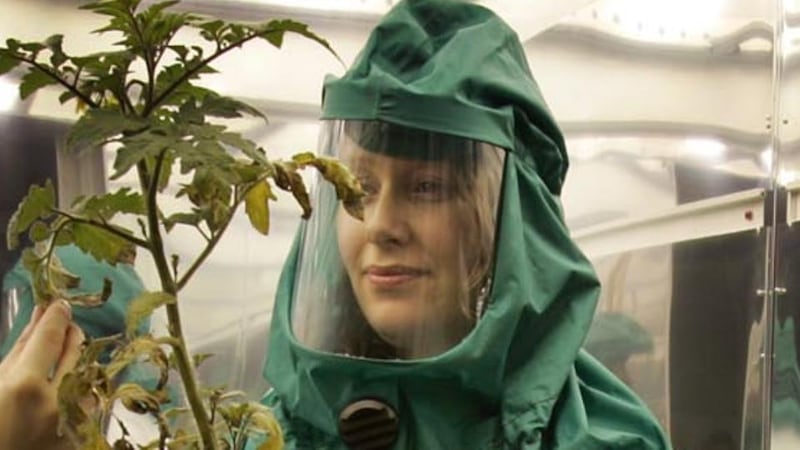A bunch of intrepid University College Dublin botanists and undergrads have braved snakes, tarantulas, bears and desert heat to collect leaves from forests and deserts. Their goal is to discover if plants are responding to rising carbon-dioxide levels in a way that increases the risk of flooding in Ireland and abroad.
Plants pull in carbon dioxide through holes in their leaves called stomata to build carbohydrates via photosynthesis. But the downside for them is that they also lose water through these same holes. The UCD scientists suspect that plants may be taking advantage of the carbon-dioxide spike (caused by burning fossil fuels) to cut down on water loss.
“Water loss is a big deal for plants, so if they find even a small increase in carbon dioxide, they can exploit that to reduce their loss of water by decreasing the number of stomata or their aperture,” says Dr Harry Yiotis, a plant scientist in UCD’s plant palaeoecology and palaeobiology group.


This could have serious implications for the water cycle and flooding, which ultimately is significant for planning decisions and infrastructure development.
"Most water is absorbed by plants, and much of it is returned to the atmosphere through the leaves. If you reduce the amount of water released in this way, plants will absorb less water with their roots and there would be more run-off," says Yiotis. It's a continuous system: soil, roots, leaves, atmosphere. Climate models include precipitation, but do not factor in the impact of subtle changes in billions of leaves.
The UCD group, led by Prof Jenny McElwain, is taking advantage of a 1980s collection of leaves that sits in the Smithsonian in Washington DC. They borrowed samples to examine the leaves, which grew at a time when the atmosphere contained far less carbon dioxide than today.
Next, they retraced the footsteps of a botanist in the 1980s, collecting leaves from 20 species in six different biomes, with funding from Science Foundation Ireland. Field trips went to the boreal forests in Alaska, Mediterranean vegetation in California, temperate deciduous in Maryland, seasonal tropical in Puerto Rica, temperate rainforests in Oregon and subtropical desert in Arizona.
Twenty-two sites were visited and some serious trekking was done. PhD candidate Michelle Murray and her colleague Dr Wuu Kuang Soh, an expert in plant identification from Malaysia, lugged all sorts of instruments to take in-field measurements of leaves and also collected leaves to dry, press and ship back to Dublin.
“This is vital information, which can be used in climate models to improve predictions of future climate-change events, such as increased risk of run-off and flooding risk,” says Murray.
Three lucky science undergrads travelled on field trips and blogged on their experiences. Fourth-year science student Kiri Fisher travelled to Alaska in 2014 to assist the team and gain experience in the field. “The hunting-down of the plants and identification of them was really interesting,” says Fisher. “I learned so much. I definitely want to do fieldwork in future.”
Perhaps the most memorable experiences, however, were encounters with some local wildlife while plant hunting. “You meet so few people, but we did have some funny run-ins with bears.”
Sophisticated models
A climate modeller has just joined the team. “These guys are plant biologists and I’m a physicist, so at the moment we are just trying to understand one another, but this kind of cross-disciplinary work is at the frontier of science,” says Conor Purcell, who is seeking to improve “some of the most sophisticated models in existence.
“The model is extremely complex. There are three million lines of code and hundreds of variables. We are looking to change one or two [plant biological] variables and assess the global response,” he says. “These variables are taken as an input for other model processes. We anticipate changes in plant transpiration rates, which ultimately affect global precipitation, groundwater levels, flood risk, and even conditions at river mouths, which could impact fisheries.”
The effect on flood risk will probably vary by location. “A dry ecosystem may not change in the same way as a tropical ecosystem,” says McElwain. “This is why we have looked at tropical, temperate, evergreen, and subtropical forests in different climate areas of the world.
"We are figuring out where plant- driven changes to the water cycle might be most prominent. We will then have a better idea of how global climate change will translate at the local level in terms of flood risk." The team of Murray, Yiotis and Soh is preparing for the next field trip in May: two weeks in the tropical rainforests of Fiji. Once there, they must present their project to the tribe elders. They will work with local botanists to find the 20 or so woody plants they are tasked with measuring and collecting. Previous blogs can be read for Alaska (purelyplants.wordpress.com) and Puerto Rico (mylastfrontier.wordpress.com)
DEEP TIME: THE FUTURE OF CLIMATE
We are moving into a climate for which there is no comparison for the past 200 million years plus, warns Prof Jenny McElwain of UCD.
Her research group is sleuthing through 200 million-year-old fossils from Greenland to open a window into past climates.
This can help scientists trace back the impact of rising greenhouse gases, such as carbon dioxide, on climates in other epochs. “There is no analogue for what’s happening now in the last 200 million years, so the only way we are going to really understand how these processes play out is by looking at the deep time record,” says McElwain.
Dr Wuu-Kuang Soh, a researcher in UCD, is trying to develop a way of calculating leaf mass from the fossils of plants that lived at the time of the dinosaurs, on the boundary of the Jurassic and Triassic periods. This marked a major period of global warming. “The aim is to incorporate what we’ve found in the past into models of today and for the future,” he says.
Little is known about the kinds of forests that existed in Greenland at that time, but the plants are known, since UCD holds a collection of fossils from about the start of the Jurassic.
Some scientists have been critical of the Intergovernmental Panel on Climate Change for not taking into account insights gained from what geologists call “deep time”, the period recorded only in the rock record. McElwain shares these concerns and argues that fossils should be part of climate-change models.














